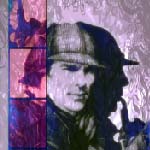The Science and Signs of Deduction

The Science and Signs of Deduction
“The ratio is always the same. 1 to 1.618 over and over and over again. The patterns are hidden in plain sight. Just have to know where to look. Things most people see as chaos actually follow subtle laws of behavior. Galaxies, plants, seashells. The patterns never lie. But only some of us can see how the pieces fit together.
7,080,360,000 of us live on this tiny planet. This is the story of some of those people.
There’s an ancient Chinese myth about the Red Thread of Fate. It says the gods have tied every one of our ankles and attached it to all the people whose lives we’re destined to touch. This thread may stretch or tangle, but it’ll never break. It’s all predetermined by mathematical probability” – Jake Bohm, Touch (Pilot episode).
Living beings are curious. All living beings follow several random sets of algorithms which can be mapped by simple to multi-directional complex flowcharts. There are times, when extreme necessity brings reasoning and curiosity into place where random set of thoughts and actions may lead to efficient solutions.
Let’s take one of the extreme examples. A plant, which is kept on a window-sill and isn’t getting enough sunlight, would alter its path of growth in order to achieve sunlight. Some would call it necessity, but this is the seed of curiosity. As a child, one has several questions in their minds, by observation or absorbing information, provided by the surroundings and people, or media, these questions start getting answered.

Making the connection, by deduction Source
But slowly, our brains start following a set chain; step-by-step reasoning and thus, we develop methods to deduce things without actually knowing the possible outcome. It might just be a trial-and-error, but slowly we start getting better at it.
There comes a time when our minds start getting so deductive, that we start to see the possible outcomes without focusing on the steps taken in between.
Now all the things in the universe follow the same sets of rules. They have some calculative and some measurable values. At times the results of these measurable values collide with a set of other measurable values of importance.
Some of you must be aware of the game 2048, where you add two blocks of the same value to create a block of a bigger value. Something similar goes on in our mind. Everything which is random, or which at times seem random might follow a set of rules, or calculations that we might not be able to fathom, due to our negligence, but the event still occurs, with or without our knowledge. The end result, hence, might surprise us. Though, if we try to be more curious, we might be able to trace the trail to its origin.
Let’s take an instance, I wake up, one morning and start humming a song, which I haven’t heard, or thought about for years. When I reach my workplace, one of my colleagues sings the same song. Now there might be several possible scenarios to this.
a) The day before you might be passing by a music shop near your office when going back to your home, that song was playing, but you were pre-occupied with thoughts, hence your conscious state of mind didn’t pay any attention to it, but that information was stored in your subconscious.
Your colleague passes the same shop, a couple of minutes later and listens to the same song, and it catches your colleague’s subconscious as well. So in the morning, next day, you both follow the pattern, and sing the same song.

Eventually, everything connects
b) You are having a discussion about a different song with your colleague, or of a specific time in the past, let’s say, the year 2000. You talk about your school days, and that triggers a chain of though in both your minds and the brain flowchart starts making the associative maps. Now years follow social trends.
Hence, the most famous songs, topping the charts of 2000, would give out a list of songs. If you add school days to it, it will filter some songs and give you a selection of songs. If your colleague was also in school, and the socio-cultural environmental conditions were the same for both of you during the year 2000. You might end up thinking about the same song, without discussing anything about the song itself.
c) It might follow a certain set of common attributes and routines in both your lives, as both of you share a good portion of your life in a similar environmental and perhaps, psychological setting, hence the algorithm might eventually become a common set of block between both of you, which just added up.
Now let’s look at the signs that we see (or don’t pay attention to) in our day to day lives. I’ll illustrate it with an example. Let’s say, I was born on the first of January 2001, I will be partial towards the number “111”. I won’t pay much attention to it, unless it’s pointed out to me. That day, I’ll see it several times. On the car-plate of the car in front of me, the last three digits of a number I am supposed to call, my invoice number from a shop, or the minutes, at which I paused the video I was watching.
Some might call it co-incidence, and they might not be wrong about it, but there is no denying that everything follows a set of behavior. The golden ratio, or 1 to 1.618 which is the crux of several natural anatomical structures, including our ears, to sea shells and our human body! These things might have a precise mathematical ratio, because of the “un-randomness” of the numbers in the whole universe and all elements in it. Have you ever wondered that atoms have the same patterns as celestial bodies, because their basis is the same?
In order to quench our curiosity, we need to get down to the base and sometimes, beyond. That’s something to think about.







